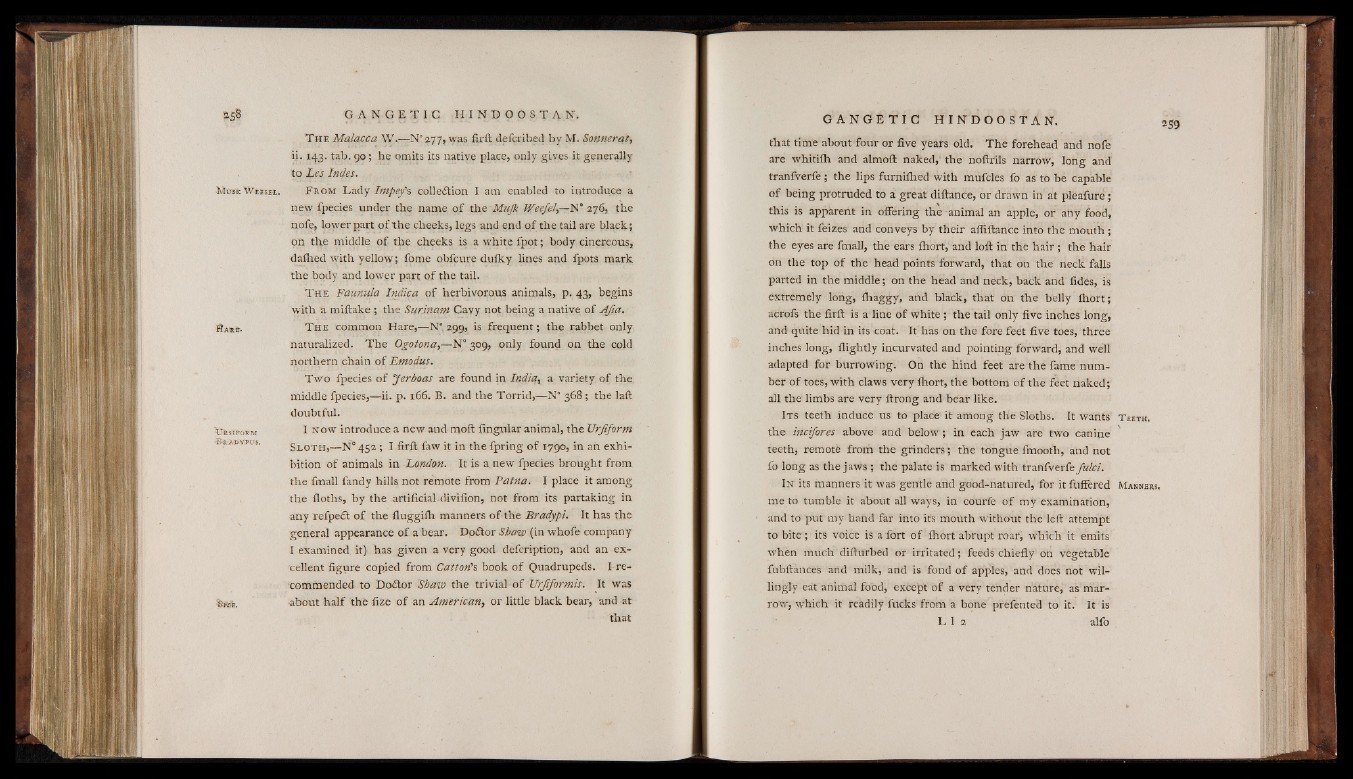
T h e Malacca W.— N° 277, was firft defcribed by M. Sonnerat,
ii. 143. tab. 90; he omits its native place, only gives it generally
to Les Indes.
■Mv sk W e e se i. F r o m Lady Impefs collection I am enabled to introduce a
new fpecies under the name o f the Muß Weefel,—N* 276, the
nofe, lower part of the cheeks, legs and end of the tail are black;
on the middle of the cheeks is a white fpot; body cinereous,
dalhed with yellow; fome obfcure dufky lines and fpots mark
the body and lower part o f the tail.
T h e Faunula Indica of herbivorous animals, p. 43, begins
with ä miftake ; the Surinam Cavy not being a native of Afia.
Hare- T h e common Hare,— N“. 299, is frequent; the rabbet only
naturalized. The Ogotona,— N° 309, only found on the cold
northern chain o f Emodus.
Two fpecies o f jerboas are found in India, a variety of the
middle fpecies,— ii. p. 166. B. and the Torrid,— N° 368; the laft
doubtful.
tÄsiFORM I n o w introduce a new and moll lingular animal, the Urfiform
S l o t h , -~N° 452 ; I firil faw it in the fpring of 1790, in an exhibition
o f animals in London. It is a new fpecies brought from
the ftnall fandy hills not remote from Patna. I place it among
the iloths, by the artificial divifion, not from its partaking in
any refpedt of the fluggilh manners of-the Bradypi. It has the
■general appearance of a bear. Doitor Shaw (in whofe company
I examined it) has given a very good defcription, and an excellent
figure copied from Cation's book of Quadrupeds. I recommended
to Dodtor Shaw the trivial- o f XJrßformis. It was
ifcfife. -about half the fize o f an American, or little black bear, and at
that
that time about four or five years old. Thé forehead and nofe
are whitilh and almoft naked,' the noftrils narrow, long and
tranfverfe; the lips furniihed with mufcles fo as to be capable
o f being protruded to a great diftance, or drawn in at pleafure ;
this is apparent in offering the animal an apple, o f any food,
which it feizes and conveys by their aififtance info the mouth ;
the eyes are fmall, the ears ihort, and loft in the hair ; the hair
on the top of the head points forward, that on the neck falls
parted in the middle ; on the head and neck, back and fidës, is
extremely long, ihaggy, and black, that on the belly ihort;
acrofs the firft is a line of white ; the tail only five inches long,
and quite hid in its coat. It has on the fore feet five toes, three
inches long, ilightly incurvated and pointing forward, and well
adapted for burrowing. On the hind feet are the fame number
o f toes, with claws very ihort, the bottom of the fëet naked;
all the limbs are very ftrong and bear like.
I t s teeth induce us to place it among the Sloths. It wants T eeth.
the incifores above and below ; in each jaw afe two canine
teeth, remote from the grinders; the tongue fmooth, and not
fo long as the jaws ; the palate is marked with tranfverfe fulci.
In its manners it was gentle and good-natured, for it fuffered M anners.
me to tumble it about all ways, in courfe o f my examination,
and to put my hand far into its mouth without the left attempt
to bite ; its voice is a fort o f ihort abrupt roar, which it emits
whèn much difturbed or irritated ; feeds chiefly! on vègetable
fubftànces and milk, and is fond of appies, and does not willingly
eat animal food, except of a very tender nature, as marrow,
w'hich it readily fucks from a bone prefented to it. It is
L 1 2 alfo